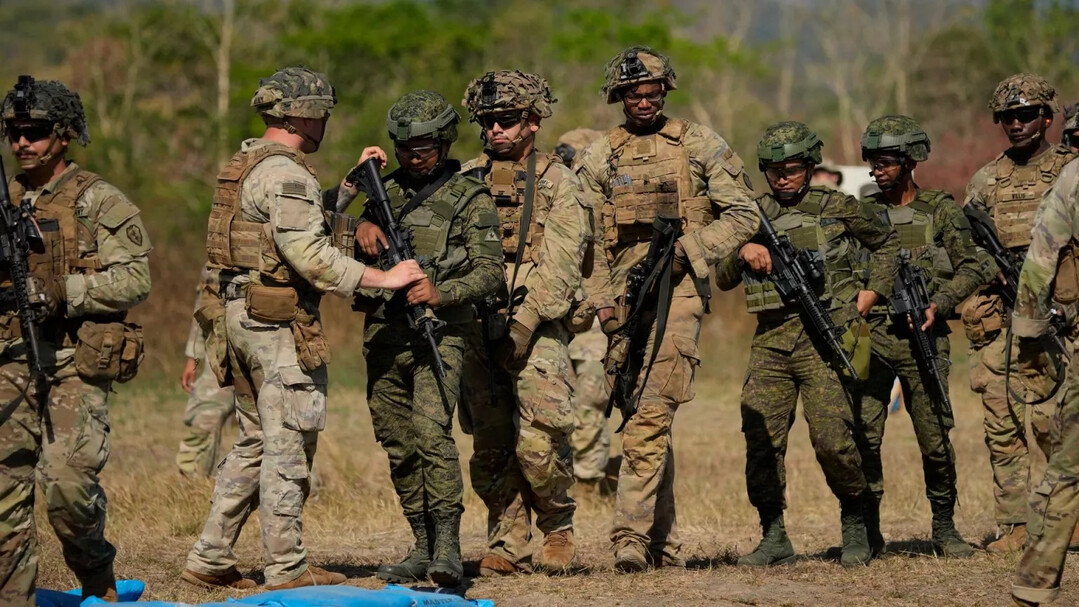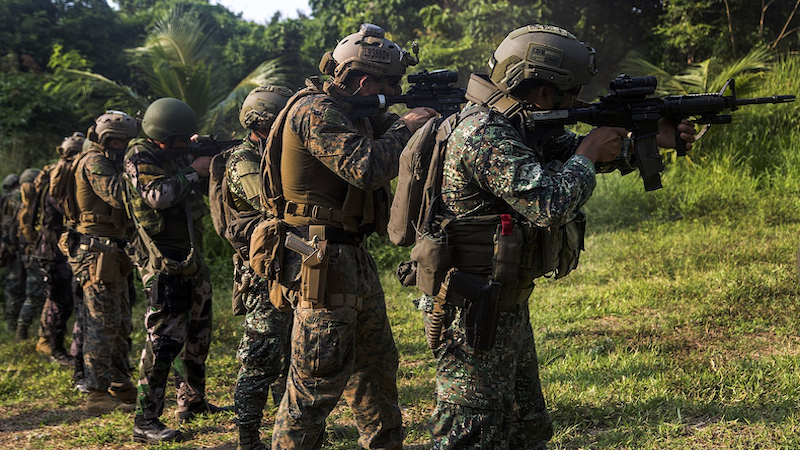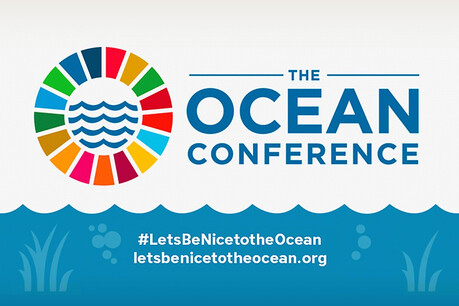
MANILA, Philippines – The U.S. Marine Corps has commenced 'KAMANDAG 9' (Cooperation of Warriors of the Sea), its largest-ever joint exercise in the Philippines, significantly expanding its military influence in the Indo-Pacific region, particularly within the First Island Chain. This exercise is expected to provide a practical opportunity to hone core U.S. Marine Corps operational capabilities, including corps-level command and control, 21st-century logistics, and air assault capabilities. The active participation of the Philippines, where security cooperation has become crucial due to territorial disputes with China in the South China Sea, and the designation of extensive training areas, signal a significant shift in the regional security landscape.
'Cooperation of Warriors of the Sea' Spans Across the Philippine Archipelago
KAMANDAG, which means "Cooperation of Warriors of the Sea" in Tagalog, marks its ninth iteration this year, with an unprecedented expansion in scale and scope. The exercise is scheduled to take place from next week across the entire Southeast Asian archipelago, from the southernmost island of Tawi-Tawi to the northernmost Batanes island chain. This move is interpreted as a focus on the practical application of the First Island Chain defense strategy, leveraging the Philippines' geographical characteristics to connect islands.
This year's exercise primarily involves the U.S. Marine Corps and the Philippine Marine Corps, with the participation of the Japan Ground Self-Defense Force and the Republic of Korea Marine Corps, solidifying its status as a multinational joint exercise. This reflects a commitment to strengthening interoperability with key regional allies and partners and enhancing the ability to collectively respond to complex security environments. In particular, the participation of the Republic of Korea Marine Corps is seen as an example of the growing importance of defense cooperation between South Korea and the Philippines.
One of the key units participating in the exercise is the Marine Air-Ground Task Force (MAGTF) based on the Marine Rotational Force-Darwin (MRF-D), which is rotationally deployed in Darwin, Australia. Established in 2012, the MRF-D's composition and role have been steadily expanded in line with the U.S. Marine Corps' 'Force Design 2030' reform and regional requirements stemming from China's military modernization. Force Design 2030 focuses on moving away from large-scale ground warfare and towards dispersed, smaller units operating organically in maritime environments, enhancing mobility and precision strike capabilities.
This year's MRF-D rotation comprises the 14th contingent from the I Marine Expeditionary Force (I MEF) based in California, and they have already been conducting operations within the First Island Chain through various exercises in the Philippines since this spring. Colonel Jason Armas, the commanding officer of MRF-D 25.3 MAGTF, emphasized the strategic importance of the training in the Philippines in an interview with USNI News, stating, "We are expanding our reach deep into the First Island Chain by transitioning what used to be seasonal training into year-round activities."

Expanding Year-Round Training in the Philippines, Utilizing Strategic Hubs
The MRF-D troops led by Colonel Armas are scheduled to participate in at least four major exercises in the Philippines this year alone. In April, they participated in Marine Exercise 2025 (MAREX 2025) in Mindanao, a breeding ground for communist and radical Islamist insurgents, alongside local Marine, Army, and police forces. This marks the second consecutive year that Australian-based Marines have trained in Mindanao, demonstrating continued U.S. interest in security threats in the region and a commitment to strengthening cooperation with the Philippines.
Immediately after MAREX, the MRF-D moved to Palawan Island in the west to participate in Balikatan 2025 with Philippine and Australian forces. During this exercise, coastal defense drills were conducted on beaches facing the disputed South China Sea, and air assault activities were carried out in Balabac, one of the nine locations where U.S. forces can be stationed under the Enhanced Defense Cooperation Agreement (EDCA) of 2014. Colonel Armas emphasized that the rotational deployments stipulated in EDCA have allowed the MRF-D to "train in unique and challenging places where we haven’t had the opportunity to train before," stating that EDCA provides the U.S. military with opportunities to train and station in strategic locations within the Philippines, contributing to enhanced rapid response capabilities in the region.
Following KAMANDAG 9, the MRF-D is also scheduled to participate in another coastal defense exercise in the Philippines later this year, the Archipelagic Coastal Defense Continuum. These continuous year-round exercises clearly demonstrate that the U.S. Marine Corps is making the Philippines a key strategic hub for its Indo-Pacific strategy.
Command and Control and Logistics Innovation, Preparing for Future Battlefields
Colonel Armas stated that in KAMANDAG 9, the U.S. Marine Corps will demonstrate its ability to extend command and control from MAGTF command to full Marine Corps command at an integrated command and coordination center. He explained, "We can command and control a MAGTF at the O-6 (Colonel) level, which is like an expeditionary brigade capability. And we can extend through augmentation from Southern California, from I MEF, to command and control a MEF forward or MEF-type formation." Colonel Armas will serve as the deputy commander in the integrated command and coordination center staff, led by a Philippine Marine Corps general, signifying enhanced joint command and control capabilities through close cooperation with allies.
Furthermore, Colonel Armas emphasized the importance of "stress-testing" the MRF-D's command and control capabilities not only in the Philippines but also across the entire Indo-Pacific. Since its arrival in the region in April, the MRF-D has commanded Marines operating in New Caledonia, Mindanao, and Palawan from its home base in Darwin. This can be interpreted as training for the practical implementation of the 'Expeditionary Advanced Base Operations (EABO)' concept, which involves long-range command and control of dispersed forces.
In addition to refining command and control capabilities, the MRF-D has learned how to maneuver and sustain itself in the Philippines in a way Colonel Armas described as "21st-century foraging." He stated, "There’s also 21st-century foraging, which is part of Force Design 2030. How are we going to leverage things through contract, like basic life support or mobility? And that became part of how we’re thriving, not just surviving, in the First Island Chain of the Philippines. We’re going to continue to do that." 21st-century foraging is a new concept for supplying military materiel by utilizing local resources and commercial means, focusing on complementing the vulnerabilities of supply chains during long-range operations and enabling rapid operational execution. This is a key element for countering enemy anti-access/area denial (A2/AD) strategies.
Diversifying Air and Sea Assets, Maximizing Mobility
While the MRF-D is organized as a MAGTF, its operations have heavily relied on aviation support assets such as Air Force C-130 transport aircraft and MV-22B Osprey tiltrotor aircraft from Marine Medium Tiltrotor Squadron 364. Colonel Armas stated, "Unlike a traditional Marine expeditionary unit, which is focused on the sea and uses Navy ships, we are heavily reliant on joint internal air fixed-wing aircraft." This demonstrates the Marine Corps' efforts to maximize mobility and expand operational reach by utilizing various air assets, not just naval vessel-based operations.
For additional movement, the Marines have utilized contracted Philippine civilian vessels such as barges and other shallow-draft ships. While the U.S. Marine Corps did not detail specific assets, hundreds of ferries and commercial landing craft tanks operate daily throughout the Philippines. Colonel Armas emphasized, "This is a tremendous opportunity to expand our mobility and multi-modal way of maneuvering throughout the Indo-Pacific." The use of civilian vessels suggests that the U.S. Marine Corps is seeking ways to improve cost-effectiveness and secure troop and materiel transport capabilities by mobilizing civilian resources during wartime.
Colonel Armas also highlighted lessons learned from the Philippine Marine Corps' 3rd Marine Brigade and 1st Marine Brigade in operating in the jungle environments of Mindanao and Palawan, emphasizing that understanding and adapting to local conditions are essential for successful operations. During KAMANDAG, the MRF-D will further enhance these capabilities by participating in core littoral terrain security operations training and air assaults.
Affirming Commitment to a 'Free and Open Indo-Pacific'
Colonel Armas underscored the strategic value that exercises like KAMANDAG bring to the U.S. and its regional partners, stating that they allow "the ability to train, operate, and integrate side-by-side with our closest allies and partners." He added, "The unity that that creates, that unity is important, and that ensures that like-minded nations are ready to uphold a Free and Open Indo-Pacific."
According to a Stars and Stripes report last year, the U.S. Indo-Pacific Command issued a warning order to the MRF-D to support Philippine forces during resupply operations for the Philippine Navy vessel BRP Sierra Madre (LT-57) at Second Thomas Shoal. Colonel Brian Mulvihill, who was the commanding officer of the rotational force at the time, told Stars and Stripes that the MRF-D was ready to support Manila, indicating the immediate readiness of U.S. military assets in the region. This is interpreted as a strong warning to China's aggressive actions in the South China Sea and a reaffirmation of the U.S.'s unwavering defense commitment to its allies.
The KAMANDAG 9 exercise is expected to play a crucial role in strengthening deterrence, enhancing interoperability with allies, and improving rapid response capabilities against potential threats in the Indo-Pacific region for the U.S. Marine Corps. This aligns with the U.S.'s strategic objective of maintaining regional stability and a rules-based international order in the face of China's maritime expansion policy in the South China Sea. Joint exercises between the U.S. and Philippine forces are expected to further expand in the future, continuously impacting the regional security environment.
[Copyright (c) Global Economic Times. All Rights Reserved.]




























